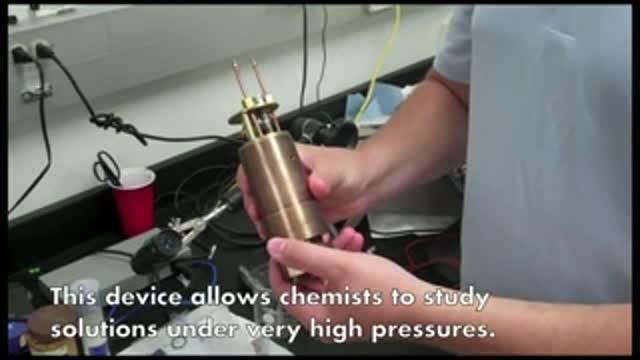A new pressure cell makes it possible to simulate chemical reactions deep in the Earth's crust. The cell allows researchers to perform nuclear magnetic resonance (NMR) measurements on as little as 10 microliters of liquid at pressures up to 20 kiloBar.
The new device allows researchers for the first time to study chemical reactions in liquid water under pressure, without it freezing into a solid.
Geochemists want to know what kind of chemistry is happening deep in the Earth's crust, beyond the reach of boreholes. These chemical reactions could affect water and minerals that eventually migrate to the surface, or the behavior of carbon cycling between the Earth's depths and the surface.

A new device iallows chemists to make nuclear magnetic resonance measurements of chemical solutions up to pressures of 20 kiloBar. Credit: Andy Fell/UC Davis Strategic Communications.
"NMR is our window into the chemical world," said Brent Pautler, a postdoctoral researcher in chemistry at UC Davis and first author on the paper. "It lets us see chemical reactions as they are happening.
"We were able to get to the point where we could no longer ignore the compressibility of the water molecules. This is the first time this has ever been reported."
"Aqueous fluids deep in the Earth are the great unknown for geochemists," said Chris Colla, a graduate student in Earth&Physical Sciences at UC Davis and co-author on the paper. "By doing NMR we can get an inside view of what is occurring deep in the Earth's crust."
For example, Pautler, Colla and colleagues have already looked at calcium ions in solution. Dissolved calcium ions can be surrounded by four, six or eight water molecules. High pressure forces dissolved calcium into an eight-water state, they found.
The high-pressure measurements could also shed light on chemical processes involved in hydraulic fracturing, or "fracking," and the behavior of buried nuclear waste over long periods of time. Fracking is the process of extracting oil and gas by injecting liquids under high pressure into rocks.
The high-pressure NMR cell was built in the machine shop at the Crocker Nuclear Laboratory with the help of Peter Klavins, research specialist in the Department of Physics, and Steve Harley, a former UC Davis graduate student now at the Lawrence Livermore National Laboratory.





Comments